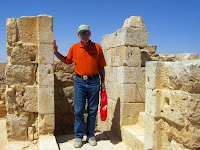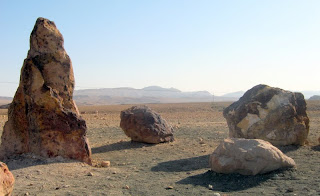As readers of this blog know, Dan & I got to take Dan home to Israel and spend a glorious month there, thanks to his winning us tickets from The
American Friends of Ben Gurion Univeristy of the Negev. My first posts were on Tel Aviv, Beersheva, the Dead Sea, Masada, and our wonderful "foodie-winey" days in the Negev Deseert. After breakfast and our morning wine tasting at
Carmey Avdat Winery in the Negev Heights, we headed for
Avdat, the spectacular ruins of a Nabatean City in the Negev Desert that was suggested to us by Prof. Rosen of
Ben Gurion University of the Negev's Dept. of Biblical Archaeology. Now a
UNESCO World Heritage Site, Avdat is located on a mountain ridge in the center of the Negev Highlands, where the routes from Petra (in present-day Jordan) and Eilat (in southern Israel) converge and continue to the Mediterranean coast. This was where the nomadic Nabateans established a road station for their caravans. Avdat was founded in the 1st century BCE and named after the Nabatean King Obodas who was revered as a deity, and who, according to tradition, is buried there. On the acropolis of Avdat, the Nabateans built a temple complex and public buildings which served as a landmark to the caravaneers. Nabatean Avdat also included a residential quarter, a military camp, and various animal pens for camels, sheep, goats, and racehorses. The early temple of Obodas was built at the end of the first century BCE, and a new temple was built on the acropolis towards the end of the 1st century CE. In the debris of the entrance way numerous inscriptions were found, including some mentioning the Nabatean King Haretat. Northeast of the acropolis was a military camp, surrounded by a wall with corner towers and a gate, which housed the riders of the camel corps units protecting the caravan routes. A unique find of the Nabataean period is the pottery workshop at Avdat, including a room with a potters wheel and a kiln for firing; an abundance of pottery, including decorated Nabatean painted ware, was found here. In the middle of the 3rd century, Avdat was resettled as part of the southern defense system of Roman Palestine and became an important military outpost and the permanent settlement of Arabian nomads. On the acropolis, a temple to Zeus Oboda was erected in 267-8, which, like the previous Nabatean temple, was later dismantled, with the stones used in Byzantine buildings. The Roman residential quarter included several dozen courtyard-type houses, built along narrow, intersecting streets, and roofed with flat stone slabs supported by arches. Avdat reached the peak of its prosperity during the 6th century, with an estimated population of 3,000; it continued to serve as an outpost in the defense of the Negev, and an effort was made to renew the Arab caravan trade and grow new agricultural crops; several wine presses have been excavated. During this Byzantine period, the acropolis area was completely rebuilt, destroying and burying the remains of the temples and buildings of the Nabatean and Roman periods; the area was divided into a religious area of a monastery with 2 churches and a citadel. In the floor of the southern church are reliquaries for the remains of local saints, and in the floor of the prayer hall of the church are the tombs of clerical dignitaries; inscriptions dating from 542 to 618 provide information regarding the Byzantine Christian community of Avdat, including the name of the church: the Martyrion of St. Theodorus, named for an abbot of the monastery at Avdat who was buried in the church.
The citadel was built for protection against marauding nomads, and the fortress was surrounded by a wall with three towers and a gate connecting it with the monastery. A large cistern was cut into the rock in the center of the citadel courtyard, and there was also a small chapel for soldiers garrisoned here. The Byzantine residential quarter was erected on several terraces, and included caves with decorations of carved bulls heads, storage spaces, and a wine press cut into the soft limestone of the hillside. The structures excavated included courtyards and rooms roofed with arches covered over with stone slabs. Excavations of Avdat were started in 1958, and in recent excavations during the 1990s, a long section of a massive stone wall and a gate was found.
At the clever suggestion of Ben Brewer of
Israel Food Tours, we sought out the 2000-year old wine press, and there enjoyed our bottle of wine from the Negev's
Rota Winery!
 |
| Sculpture at Avdat |
 |
| Dan, Avdat |
 |
| Elisse, enjoying Avdat |
 |
| Sculpture in Avdat |
 |
| Dan, with out bottle of Rota Vineyards wine, in the 2000 year old wine press! |
 |
| Elisse, enjoying modern Israeli wine in an ancient place... |
 |
| Dan in the ancient wine press, Avdat |
 |
| Preacher Dan! |
 |
| Greek Inscriptions |
 |
| Greek Inscriptions |
 |
| Modern sculpture & ancient ruins... |
From Avdat we drove through the Makhtesh Ramon - the
Ramon Crater; Israel's answer to the Grand Canyon! 500 meters deep, 40 kilometers long, and 10 kilometers at its widest point, it's the largest of the 3 craters of the Negev, & the largest in the world! It is an amazingly beautiful place, and makes you think you're in Montana, or New Mexico, or Arizona- and yes, "Spaghetti Westerns" were filmed here! These craters were not created by meteorites, but are a unique geological phenomenon, and not to be found anywhere else in the world!

 |
| Yes, "Spaghetti Westerns" were filmed here! |
 |
| Petrified forest in the Negev... |
 |
| New Mexico? Arizona? Montana? No- this is Israel! |
 |
| Chillin' out in Mitzpeh Ramon! |
 |
| This made me laugh: 400 kinds of vodka, along with other pain killers, at the Mitzpeh Ramon grocery... |
 |
| Relaxing with a cappuccino at Mitzpeh's internet cafe... |
 |
| The hotel we stayed in in Mitzpeh Ramon |
 |
| I loved this painting on the hotel's elevator door... |
 |
| Gourmet ice creams- & date liquer and other goodies- at a gas station in the desert! |
After driving thru the canyon, we spent the night in Mitzpeh Ramon, and had a surprisingly great dinner in town! And in the morning we headed south for Eilat and the Red Sea!
Next: Biblical animals, Solomon's Mines & Egyptian Temples, and the Red Sea!

































1 comment:
I really liked the article, and the very cool blog
Post a Comment